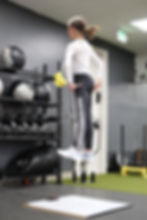VERTICAL JUMP HEIGHT: WHAT DOES IT MEAN & HOW CAN I IMPROVE?
- Anthony Tran
- Jun 1, 2023
- 3 min read
Vertical Jump Height is a metric that athletes, parents, and coaches are commonly interested in knowing. Here at Virtus Performance Club, it is the #1 metric that we are asked about on a consistent basis. Why is that? Follow along to find out!
What & Why?
Vertical Jump Height is how high you can jump off the ground. It can be off two-legs, one leg, with an approach, standing still etc. but simply put it is measuring the height someone gets off the ground. There are many variations and different ways to test this, whether you are jumping up to touch something or using a piece of equipment like a jump mat/force plates or an app that measures for you.

So why all the interest in this one metric? In many sports, jump height will directly impact specific skills of the sport. Whether it’s a spike in volleyball or rebounding/defending/attacking the rim in basketball there can be direct correlation to jump height, and athlete effectiveness in their specific sport.
Jump height however is not only important for sports that jump vertically. It is a good indicator of lower body strength, power, athleticism, and coordination, and all those characteristics can apply to almost any sport. It’s also very easy to measure consistently over time because the only thing you need is your body!
What Do My Numbers Mean?
After testing your vertical jump, you’ll come away with a number in inches or centimeters. How will you know if that is good or bad? The best form of comparison is to test consistently over a period of time, and compare your results to yourself! While we all want to know who can jump the highest on the team, or if we jump high enough to play on Varsity/College/Pro, everyone starts at a different point, so consistently testing and looking for improving trends will give us the best indicator if our training is working.
While this article is about jump height specifically, there is equipment out there that is advanced enough to give us other metrics based off a vertical jump, such as force plates. Those can give us power metrics, speed metrics, right vs. left leg metrics, and so much more. If you’re interested in more information about force plates, click HERE.

My Last Jump was worse than the week before, what does that mean?
Progress is not linear, especially in sport! While it’s easy to get caught up in the narrow view of “did my jump get better or worse?”, true progress takes time. You should be looking at jump heights over a long period of time, months, quarters, and even years!

Many things can also affect vertical jump on a day-to-day basis. Has practice for your sport been difficult? Did you get a bad night of sleep? Are you in a heavy and intense training cycle? All of these factors can play a role in whether your jump on that specific day will be higher or lower than normal, so consistently testing and looking at long term trends will give us a better idea on how our vertical jump is progressing.
How do I Improve?
Many different things go into improving jump height, but the most important factor is finding a coach/program that is thoughtfully planned to fit your specific goals, needs, and schedule. Outside of that, here are a few key factors to help improve your jump height:
Get Stronger: Especially at an early training age, increasing overall lower body strength will help with body composition, muscular development, and force production.
Plyometrics/Power Development: Supplementing your strength training with weighted jumps, rebounding jumps, sprinting, medball throws, and other forms of power work is a key part in trying to increase vertical jump.
Jump Strategy: Many have never thought about how they jump, and potentially more importantly how they land! Working with a professional to clean up any movement inefficiencies can make a big difference!
Recover: An often overlooked part of jump height is the recovery aspect. Some athletes go through months and years of playing the same sport +7x a week without ever truly getting a break, supplementing with strength training, or going through proper recovery. This build up over time can negatively affect jump height!

In the end, participating in a program/working with a coach who will measure your jump height consistently, and incorporate the proper combination of strength training, plyometrics, power development and recovery practices will ultimately be the best way to improve your jump height!
